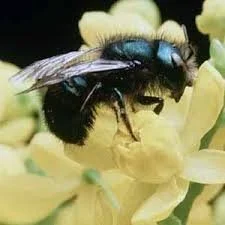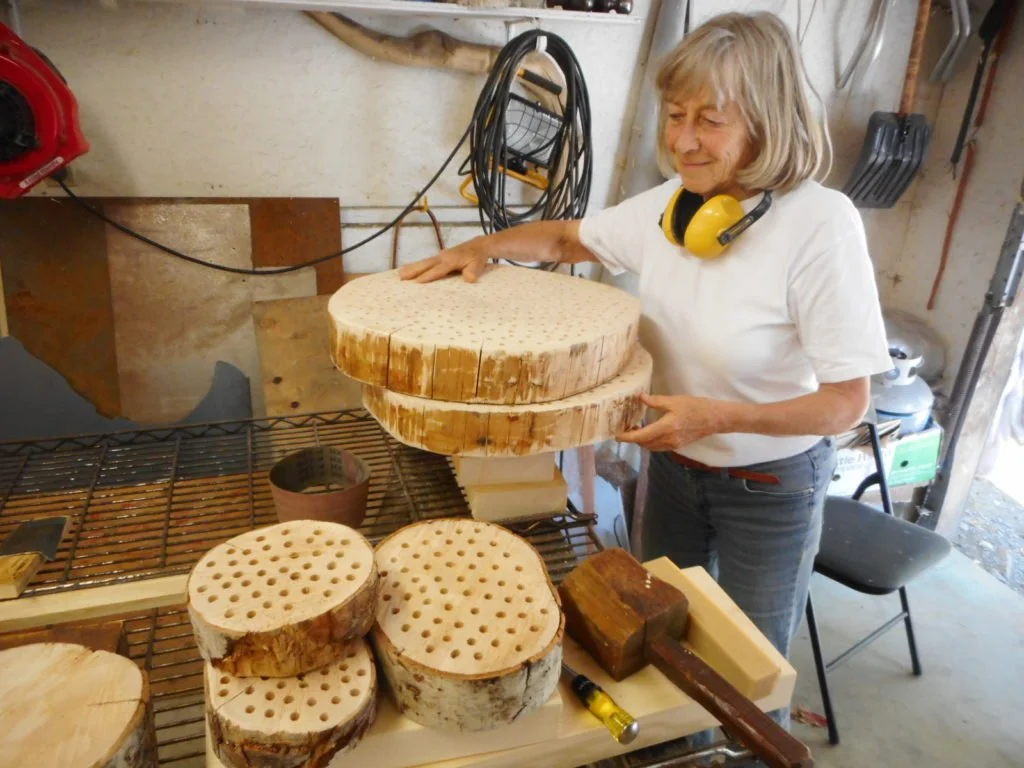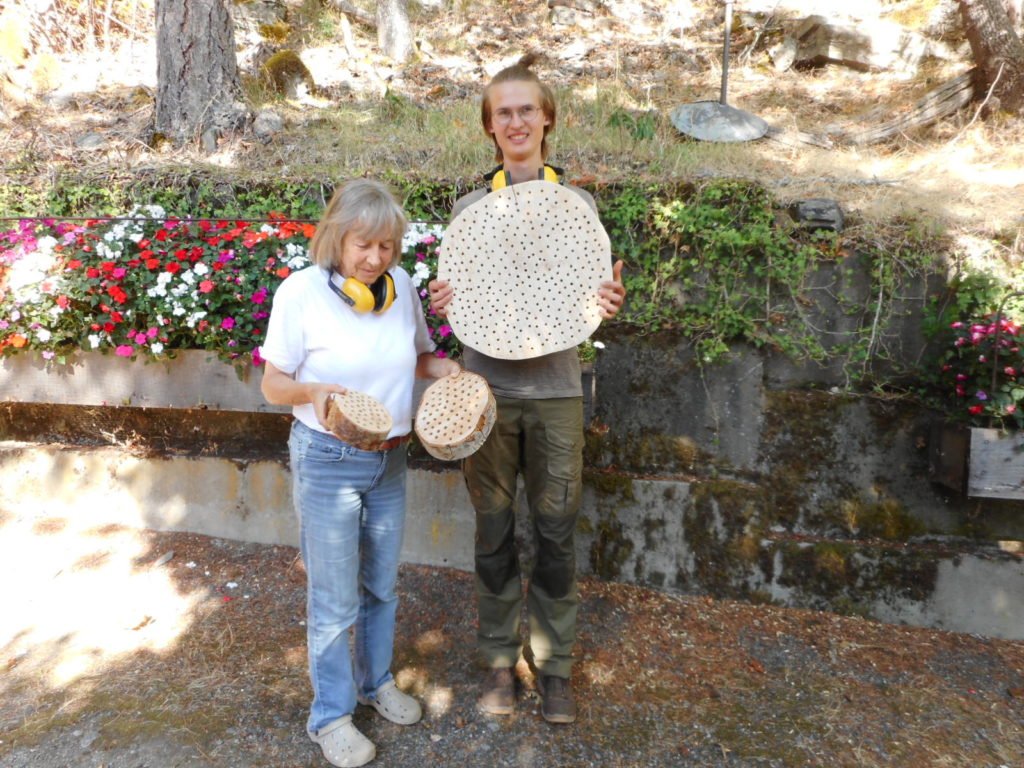Amazing Orchard Bees
In a follow-up to our AGM and encouraged by the positive feedback regarding our"insect pollinator habitat improvement" proposal, I decided to do some additional research on the subject of dwindling insect pollinator populations worldwide and share it with you. I also would like to provide you with a bit more background information on orchard bees, which are specifically targeted by our project.
You may well be aware of the importance of pollination considered one of the most important ecological processes on the planet. It is noteworthy that Canada is home to over 1,000 pollinating animal species ranging from numerous bee species to butterflies, moths, hummingbirds and others. Most of the edible plants in our gardens, farm produce, flowers and ecosystems depend on pollination, with pollinators contributing billions of Dollars to our economy. It is self-evident that any adverse impacts on pollinators such as habitat degradation and loss,unfavourable agricultural practices and use of pesticides, invasive species,diseases and infections, and last not least climate change are reasons for grave concern. We therefore should do everything which helps pollinating species to survive and to thrive, be it in your garden, orchard, the estuary or other terrestrial ecosystems.
The orchard mason bee is named for a good reason: it is the most common wild bee species pollinating our fruit trees but also visits many other flowering plants. It is the most used pollinator species that is artificially bred for the use by orchard owners. Although it is found everywhere in our area their wild populations are in decline as attested to by orchard farmers and gardeners, the reason for our focus on this species. The following Wikipedia text on the life and breeding of the orchard bee may be of interest to you. I added a couple of photos to show how this bee species looks like.
"Osmia lignaria, commonly known as the orchard mason bee or blue orchard bee makes nests in reeds and natural holes, creating individual cells for its brood that are separated by mud dividers. O. lignaria is a common species used for early spring bloom in Canada.
Reproduction cycle
When a female is ready, she seeks out a suitable nest. O.lignaria females nest in narrow holes or tubes, though they have been found to nest inside cedar shakes and even keyholes. Beekeepers place prepared nesting materials to entice the females to stay close to the orchard or nearby forage. Good nesting material (reeds, paper tubes, wood trays, or"bee condos") are as important as having the proper mud available(silty/clayey, as well as correct moisture content to grab/pack the mud). Af emale might inspect several potential nests before settling in. Once she has found a preferred nesting cavity, she flies outside of the hole and does anin-flight dance. She is orienting on major visual features to find her nest when she returns from foraging.
Orchard mason bees arrange their nests as a series of partitions, with one egg per partition. A female begins the process by collecting mud and building the back wall, if necessary,of the first partition. She then makes several back-and-forth trips to nearby flowers. Unlike honey bees which visit flowers that are miles away, females visit flowers nearest the nest. One bee can visit 75 flowers per trip, and it takes 25 trips to create a complete pollen/nectar provision. The female works tirelessly during the day, only stopping once the sun has gone down. When the sun rises the next morning, she basks in its rays until warm enough to fly,then continues foraging.
Once the pollen provision is large enough, she backs into the hole and lays an egg directly upon it. She then collects more mud to seal off the partition. The new wall also doubles as the back wall of the next cell, and she continues until she has filled the nest hole with a series of offspring. O. lignara bees,like many insects, can select the gender of the egg they lay by fertilizing the egg, or not. Unfertilized eggs are males, while fertilized eggs are females.The adult bee lays female eggs in the back of the burrow, and the male eggs towards the front. On average, she lays about three males and one to two females per cavity. Because females are larger than males and require more pollen reserves, cavity dimensions can play a significant role in the cavity selection process.
When the egg hatches, the larva consumes the food provision and goes through many changes before becoming an adult. It will spend most of its life alone in this dark cell made by its mother.
Once the female has finished the nest, she plugs the entrance with a mud wall, thicker than the partitions that precede it. She then seeks another location for a new nest. She works tirelessly until she dies. An O. lignaria female lives for about four to eight weeks, and can fill an average of four six-inch tubes in her lifetime, with about eight eggs per tube. Her work includes nearly 60,000 blossom visits, and has attracted growers to propagate the insect for pollination purposes in fruit orchards".
The bee habitat discs we produced and displayed at the AGM serve a dual purpose: providing Key habitat to orchard bees and helping to raise funds for CERCA. Pollinators are needed wherever you live. They are essential for the salt marshes and dyke vegetation of the precious estuary, as much as your gardens, orchards and flower boxes on your balcony or deck! If you provide bee housing you know that it is for a good cause: to make this a better world!
What you can do!
Imagine you are so lucky with oneof the large tree discs that all 300 tubes are filled with six eggs per tube.The contribution this would make to the local bee population and plantspollinated is staggering. Assuming two female pupas per tube reaching adult stage,one disk would add 600 females to the population. Assuming an average of 25trips per female to collect sufficient pollen for six new chambers, visiting 75flowers per trip, the total flowers fertilized would amount to more than 1,000,000 blossoms!!
I have very successfully used the tree disks at our place at the foot of Mount Tzouhalem for more than 20 years. At least three quarters of all tubes are occupied every year. The optimum exposure to hang the discs appears to be south/ south-west which gets the full sun in early spring when the bees start to emerge. I found that shaded places don't work so well. I also discovered that bees re-use holes that are not completely cleaned out after the adults have left their hole. However it is a good idea to clean the tubes once per year to prevent contamination of the tubes and spread of diseases. Some people use straws shoved into the tubes; I prefer a drill for cleaning out the holes. It goes quick, is efficient and leaves a natural habitat. Plastic straws are not recommended and should be banned anyway!
We offer three sizes of tree discs:
Large: with 230 to 300 holes for a donation of $35 (minimum...)
Medium: with 55 to 85 holes for a donation of $20
Small: with 38 to 45 holes for a donation of $15
Please let me know if you areinterested in donating a disc or two in support of CERCA's efforts in restoringthe estuary's ecological integrity. We have a few discs of all sizes ready togo to your place!
Dr. Goetz Schuerholz
Chair CERCA





